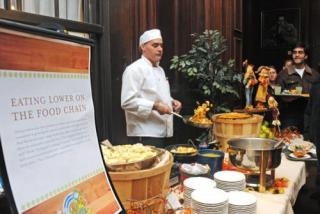The introduction of new color-coded food into several dining halls as part of a senior thesis project investigating whether colors make people eat stuff has drawn criticism from a wide range of students. Chief among the concerns voiced is the number of colors used in the experiment, which has quickly exceeded two dozen and threatens to surpass the chromatic sensibilities of all but the most hardened VES concentrators.
The initiative, co-sponsored by Harvard University Dining Services and Massachusetts General Hospital, involves placing stickers on food labels, which communicate the nutritional value of each item. For instance, a red sticker means “high in saturated fat and sugar”, a green sticker means “low in saturated fat and sugar”, and a yellow sticker means “just enough saturated fat and sugar to make you feel kind of guilty”. A blue sticker means “high water content—you’re going to have to pee after eating this.” A turquoise sticker means “a little bit sugary, but not enough to help your hypoglycemia.” A grey sticker means “high quantities of iron and fiber,” and a mustard sticker means “mustard.”
According to Pat Rearky ’17, a volunteer with Harvard’s Eating Concerns Hotline and Outreach (ECHO), the number of stickers is dangerous for people who may already be struggling with food choices. “Many students already have to deal with health, nutrition, and body image issues, and now suddenly they’re confronted with these colors,” a visibly distraught Rearky noted, “What do they mean? What does anything mean? Who are you again? For that matter, who am I? What does it mean to be?”
New stickers introduced this week in Mather House involve three new colors which are only distinguishable in the ultraviolet spectrum. For most students, these will simply appear as white, but for those who either wear specially designed glasses or are bumblebees, the hues will help them differentiate between varying levels of potassium.
Senior Michael J. Roxbury ’15, who is conducting the study, explained in an email sent to the participating upperclassmen houses that he was inspired to conduct the sticker study after watching a revival of Joseph and the Amazing Technicolor Dreamcoat. “I thought to myself, ‘Why should we only keep colors on a coat?’ And then, I realized, there is no reason. We, too, can eat a dazzling coat of many colors.
“Therefore, dining halls must be decked with stickers that are red and yellow and green and brown and scarlet and black and ochre and peach and ruby and olive and violet and fawn and lilac and gold and chocolate and mauve and cream and crimson and silver and rose and azure and lemon and russet and grey and purple and white and pink and orange. And blue.
When asked for comment, however, most students responded that they were probably going to just eat at the grill.



